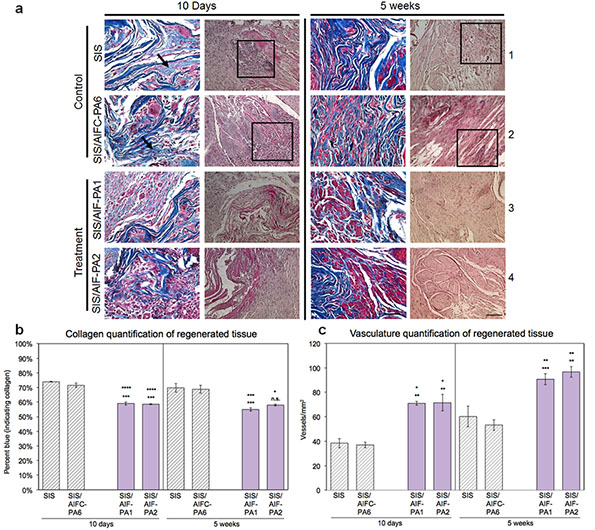-->
|
Back to 2014 Fall Congress Meeting Abstracts
Anti-Inflammatory Self Assembling Nanomolecules Enhance Bladder Regeneration
Edward C. Diaz, MD1, Matthew I. Bury, MS1, Natalie J. Fuller, BS1, Jay W. Meisner, BS2, Matthias D. Hofer, MD, PhD3, Vani S. Menon, MD4, Earl Y. Cheng, MD1, Arun K. Sharma, PhD1.
1Ann and Robert H. Lurie Children's Hospital of Chicago, Chicago, IL, USA, 2Northwestern University, Chicago, IL, USA, 3Northwestern University Feinberg School of Medicine, Chicago, IL, USA, 4Loyola University Health System, Maywood, IL, USA.
BACKGROUND:The urinary bladder is subject to pro-inflammatory molecules when biologic/synthetic scaffolds are used for augmentation. Successful tissue recapitulation requires a balance between native regenerative processes and the immune response. Excess inflammation can result in fibrosis and poor bladder regeneration and function. This study seeks to evaluate whether nanomolecules in the form of self assembling peptide amphiphiles (PAs) engineered with anti-inflammatory epitopes could temper the inflammatory response and promote tissue regeneration.
METHODS:Anti-inflammatory PAs were synthesized utilizing standard chemistry procedures (PA1 and PA2=test samples; PA6=sequence scrambled control). PAs were purified and characterized by HPLC and mass spectroscopy, respectively. PAs were induced to undergo self-assembly with the addition of 5mM CaCl2 at room temperature and became a highly viscous liquid. 0.5cm x0.5cm samples of small intestinal submucosa (SIS) were immersed into each PA and immediately used for bladder augmentation in a rat hemi-cystectomy model. Non-treated SIS was also used as a control. Bladder tissue was analyzed 10 days and 5 weeks post implantation through Masson’s Trichrome staining and immunostaining with markers associated with inflammation (CD68 and myeloperoxidase). Collagen and muscle content and angiogenesis were determined via quantitative morphometrics. SIS was chosen as scaffolding material due to its inflammation provoking properties in vivo.
RESULTS:
10 DAYS: Trichrome bladder tissue staining of PA1, PA2 (n=3 each), PA6 (n=2) and untreated SIS (n=2) yielded 59.1 ± 1.1%, 58.6 ± 0.4%, 71.5 ± 1.4%, and 73.9 ± 0.2% collagen content, respectively. Vessel quantification (vessel number/mm2) was 71.0 ± 1.5, 71.5 ± 6.7, 37.0 ± 2.3 and 38.5 ± 3.8, respectively. CD68 expression (% positive) was 33.4 ± 2.0%, 23.1 ± 3.3%, 66.5 ± 2.4%, and 66.9 ± 2.4% while myeloperoxidase expression (% positive) was 6.9 ± 0.7%, 9.0 ± 0.5%, 22.1 ±1.6%, and 23.1 ± 1.8%, respectively, for PAs 1,2,6 and untreated SIS.
5 WEEKS: Trichrome bladder tissue staining of PA1 (n=2), PA2 (n=3), PA6 (n=3) and untreated SIS (n=3) revealed collagen content of 55.0 ± 1.2%, 58.0 ± 0.6%, 68.8 ± 2.7%, 69.8 ± 2.1% while vessel quantification revealed 90.7 ± 4.5, 96.7 ± 4.4, 53.3 ± 4.4, and 60.2 ± 8.5 vessels/mm2. CD68 expression was 17.6 ±1.8%, 16.5 ± 1.6%, 42.0 ± 2.6%, and 46.0 ± 3.9%. Myeloperoxidase expression was 5.2 ± 0.7%, 7.2 ± 1.1%, 17.6 ± 1.0%, and 17.6 ± 1.8%. All measurements were taken in areas of tissue regeneration. Values represented as mean±SE.
Figure 1a demonstrates histologic findings between control and treatment groups, Figure 1b summarizes differences in collagen content between groups, and Figure 1c summarizes differences in vascular quantification between groups.
CONLCUSIONS:Engineered self assembling PAs represent a novel tool that can modulate inflammation and aid in aspects of bladder regeneration, such as muscle formation and angiogenesis. This effect on inflammation and regeneration is evident up to 5 weeks post surgery.

Back to 2014 Fall Congress Meeting Abstracts
|


